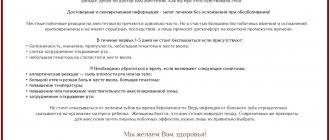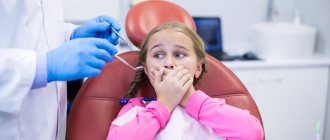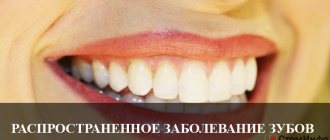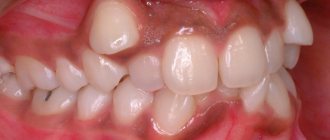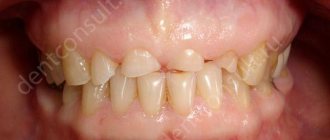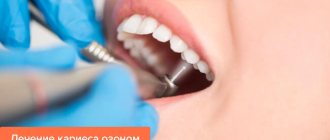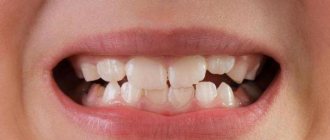Many people suffer from severe toothache, but do not dare to make an appointment at the clinic, but in vain. Modern dentistry is completely safe; doctors use many advanced technologies.
Quite common procedures include dental treatment under anesthesia. There is no pain or discomfort during the therapy, which is why it is in demand. Dental treatment under anesthesia is suitable not only for people who experience panic and fear of visiting the dentist, but also for those who face long-term complex treatment of the dentition and oral cavity. Dentists at the New Century clinic use only certified pain relief products.
In some cases, anesthesia may be contraindicated. This applies to people with heart disease and respiratory diseases. The procedure is dangerous for patients with kidney problems. Before proceeding to treatment under anesthesia, the doctor will prescribe the necessary tests. It is important to remember that such treatment should be performed under the supervision of qualified specialists and only in a clinic equipped with an intensive care unit. Specialists must be licensed to carry out these procedures.
The dentist must determine the type of anesthesia and dosage of the drug in accordance with the diagnostic results obtained. After treatment under anesthesia, the patient returns to a normal state.
The effects of anesthesia do not cause a negative effect on the patient if it does not have contraindications. Treatment under anesthesia will take about two hours.
Treatment under anesthesia is prescribed in the following cases:
- The patient is allergic to local anesthesia;
- severe fear and panic that a person cannot cope with on his own;
- the occurrence of a gag reflex during therapeutic manipulations;
- a large number of teeth to be treated;
- impossibility of therapy without surgery;
- removal of highly complex wisdom teeth.
General anesthesia allows the doctor to concentrate and approach treatment more carefully. This method is used to remove a large number of teeth or for implantation.
Complex tooth extraction
Complex tooth extraction is performed if it is impacted (cannot erupt from the gum, that is, hidden under it, or erupts on only one side) or dystopic (grows horizontally or at an angle). In children, this process is observed with a sharp replacement of primary incisors with permanent ones. But more often, wisdom teeth (third molars) are susceptible to dystopia and retention. They put pressure on neighboring bone formations or the cheek, causing pain to the person and distorting the dentition.
Complex extirpation differs from simple extirpation in that at the beginning of the procedure, the surgeon makes an incision in the gum to peel off part of the membrane and reveal the crown. Then the tooth is captured and extracted. Instead of forceps, a dental elevator is used, immersing it in the place between the mucous membrane and the root. The tool pushes the root out of the hole with rotational movements.
In severe cases, a drill is used. With its help, the crown is cut and parts are removed one by one. After removing the wisdom tooth, the wound is sutured. The third molar socket heals more slowly than other molars (about 2 weeks).
Our prices
| CODE | GENERAL TYPES OF WORK | PRICE, RUB) |
| 0.01 | 1st inspection, consultation, drawing up a plan | 350 |
| 0.02 | Repeated appointment, professional examination | 200 |
| 0.03 | Computer radiovisiography of teeth | 200 |
| 0.04 | Repeated radiovisiographic image | 150 |
| 0.05 | Infiltration anesthesia | 250 |
| 0.06 | Conduction anesthesia | 300 |
| 0.07 | Isolation of a group of teeth before filling (cofferdam) | 350 |
| CODE | SEDATION | PRICE, RUB) |
| 12.01 | Xenon inhalation (1 procedure) Use of an individual mask and filter for inhalation | 3500 |
Indications and contraindications
If the patient has a stable psyche and is not prone to allergies, he will calmly tolerate treatment and tooth extraction under local anesthesia. But in some cases, anesthesia is practiced. Indications include the following:
- sensitivity of the body to local analgesics;
- simultaneous removal of several units;
- low pain threshold;
- panic fear;
- uncontrolled gag reflex;
- complex cases (branched roots, fragments of teeth, fusion of the root with the jaw, etc.)
Problematic cases include the removal of third molars, or wisdom teeth, which cause more trouble than they are worth. Sometimes they grow horizontally and have deformed canals - then extraction is fraught with great difficulties. Therefore, wisdom tooth removal under anesthesia is a common practice in European countries.
Anesthesia is not used for diseases of the heart and respiratory system, epilepsy, endocrine pathologies, post-infarction or post-stroke condition. Not prescribed for pregnant and elderly patients, or persons who have recently suffered alcohol or drug intoxication.
Treatment under anesthesia
In what cases is treatment under anesthesia necessary?
First of all, it is recommended to treat teeth under anesthesia for children with diseases of the central nervous system: autism, cerebral palsy, Down syndrome, if this is not possible under normal conditions. When the child is too young to endure long-term treatment, it is also worth using anesthesia. Dental treatment under anesthesia is recommended if the child requires urgent sanitation of the entire oral cavity, for example, before surgery.
Finally, when a child has multiple complicated caries and refuses to be treated voluntarily, the order of the Ministry of Health of the Russian Federation of November 13, 2012 No. 910n, paragraph 19 comes into force. In accordance with it, a child with multiple pulpitis must be treated under anesthesia.
What drug is used for anesthesia?
At the NovoDent clinic on Tolyatti, 70a, the Sevoran inhalation solution is used for anesthesia. This is a modern, high-quality and safe drug for inhalation anesthesia, which is used all over the world. It is low-toxic, so it is used when working with children. With the help of Sevoran, the little patient quickly falls into sleep and easily comes out of it.
Important! Sevoran can cause slight dizziness after waking up, which goes away within half an hour. After complete recovery from anesthesia, pain sensitivity can quickly return. In rare cases, vomiting and nausea may occur.
How does sleep occur?
When the child is already sitting in the chair, the anesthesiologist administers the inhalation solution through a breathing mask covering the mouth and nose. For the patient to fall asleep, 5-7 breaths are enough. After which the doctor installs a laryngeal mask
. It is made of soft and thin latex. Its size is selected depending on the patient’s weight.
It is inserted through the mouth and placed in the trachea. The mask ensures breathing during treatment.
a laryngoscope during anesthesia
– a metal device that can injure the larynx.
How does a child recover from anesthesia?
After the treatment is completed, the doctor removes the laryngeal tube and transfers the small patient to the bed. It will take half an hour to an hour to fully awaken. During this time, medicinal sleep will smoothly transform into physiological sleep. The mood in which the baby wakes up after anesthesia also depends on the parents. Try to meet your child with a smile, without anxiety and unnecessary questions about pain and teeth. The calmer you are, the faster your recovery will be.
You can go home only after the anesthesiologist examines the child and the dentist gives recommendations for further dental care.
What needs to be done before treatment?
- Obtain a certificate from a pediatrician stating that the child is healthy. The certificate is valid for 14 days.
- Do a general detailed blood test (platelet count, blood clotting time and bleeding duration). The analysis is valid for 14 days.
- Do an ECG.
- Get a statement from a specialist if you are registered with someone.
On the day of treatment
Stop giving food and drinks (except water) to your child 6 hours before the procedure. Do not even give water for 4 hours. Don't brush your teeth. Bring a change of clothes and a bottle if needed. Please arrive 15 minutes before your appointment. Don't forget to take a certificate from your pediatrician and tests. Treatment will not begin without a follow-up examination with an anesthesiologist.
Important! Do not vaccinate 2-3 weeks before treatment under anesthesia.
How to prepare your baby for the procedure?
Do not hide from your child that he is undergoing treatment. Talk about it calmly, like you would about any other ordinary event. Let this be an easy conversation in which going to the dentist is presented as an intermediate step. The main thing in the conversation should be some positive event that will happen after visiting the clinic. For example:
“On Wednesday we will go to the dentist, there we will breathe in the magical air, fall asleep and a fairy will fly in and make our teeth white, so that on Sunday we can go to the circus healthy and beautiful.”
You can make an appointment for treatment under anesthesia with Ekaterina Viktorovna Kapustina or Alina Vladimirovna Zhdanova, Togliatti, 70 a. tel., (3843) 76-44-40. Only these pediatric dentists in Novokuznetsk offer this service.
Tooth extraction under general anesthesia
General anesthesia is rarely used during this procedure and only according to the indications of a dentist. Such exceptional cases include:
- presence of panic fear in the patient before the upcoming procedure;
- aggravated gag reflex in the patient, which may interfere with the operation;
- high complexity and traumatic nature of the upcoming intervention;
- the patient has an allergic reaction to drugs used in anesthesia. Etc.
We must not forget that the use of general anesthesia can have negative consequences for the human body, especially in old age. In addition, the patient may require an additional recovery period, whereas with local anesthesia, the patient can go straight home after the procedure is completed.
Dental treatment in Kazan
Dental treatment under anesthesia for children and adults in Kazan: addresses and telephone numbers of clinics, prices, reviews.
– Rating of dental clinics and clinics.
– Treatment of dental caries under sedation, under a microscope, laser. Promotions and discounts, installments, credit.
Flagship Address: Kazan, Pobeda Ave., 46A Telephone, +7 (904) 712-25-88
Reviews: 0
Albadent Address: Kazan, st. Akchulpan, 2A Telephone
Reviews: 1
Teeth whitening Brilliant Smile Address: Kazan, st. Academician Glushko, 9k2 Telephone
Reviews: 0
CityStom Address: Kazan, st. Julius Fuchik, 62A Telephone, +7 (937) 625-30-37
Reviews: 0
Dental clinic Blago Address: Kazan, st. Julius Fuchik, 99A Telephone,
Reviews: 0
A-dentists Address: Kazan, Leningradskaya street, 60B Telephone
Reviews: 0
Dentistry Happy Dent Address: Kazan, st. Julius Fuchik, 78 Telephone (single), +7 (937) 625-41-01
Reviews: 0
Alba Dent Address: Kazan, Dubravnaya street, 51B Telephone, +7 (937) 625-42-02,
Reviews: 0
AlbaDent Address: Kazan, st. Julius Fuchik, 52Ak1 Phone
Reviews: 0
Family Dent Address: Kazan, Daurskaya street, 44G Telephone
Reviews: 0
Consultative and diagnostic center of the Aircraft Construction District Address: Kazan, st. Lukina, 10 Phone, +7 (843) 524-95-15, +7 (843) 524-95-95
Reviews: 0
Dentistry Smile Clinic Address: Kazan, st. Bondarenko, 14 Telephone,
Reviews: 0
1
The use of general anesthesia is necessary when working with children, during long operations, or in the presence of panic fear of dentists. Anesthesia is used in the treatment of caries, pulpitis, dental cysts, gum inflammation, bone grafting and implant installation. General anesthesia is indicated for panic, neurological disorders, and long-term work. Prices start from 1200 rubles. The use of laser and dental treatment under a microscope in children and adults without pain is an alternative to anesthesia. If there are no indications, local anesthesia will be sufficient.
New technologies in the treatment of caries: laser, ozone, chemical-mechanical system, air-kinetic method, Vector apparatus.
Caries is a complex, slow-moving pathological process that occurs in the hard tissues of the tooth and develops as a result of the complex influence of unfavorable external and internal factors. In the initial stage of development, caries is characterized by focal demineralization of the inorganic part of the enamel and destruction of its organic matrix. Ultimately, this leads to the destruction of hard tissues with the formation of a cavity in the dentin, and in the absence of treatment, to the occurrence of inflammatory complications from the pulp and periodontium.
Kazan is a city in the Russian Federation, the capital of the Republic of Tatarstan, a major port on the left bank of the Volga River, at the confluence of the Kazanka River. One of the largest religious, economic, political, scientific, educational, cultural and sports centers in Russia. The territory of the city of republican significance Kazan is divided into 7 administrative-territorial units - districts (districts in the city) that are not municipalities: Aircraft Building, Vakhitovsky, Kirovsky, Moskovsky, Novo-Savinovsky, Privolzhsky, Sovetsky. Population 1,243,500 people, telephone code +7 843, postal codes 420xxx.
